Reconstruction of Summer Rainfall over the Last Five Centuries Based on Oak Chronology (Western Pomerania, Poland)
Abstract
1. Introduction
2. Materials and Methods
2.1. Study Area
2.2. Climate and Climate Data
2.2.1. Air Temperature
2.2.2. Precipitation
2.3. Dendrochronology Data and Dendroclimatic Analyses
3. Results
3.1. Regional Chronology
3.2. Climate–Growth Relationships
3.3. Climate Reconstruction
3.4. Analysis of Historical Records
3.5. Verification of the Reconstruction Based on Historical Records
4. Discussion
5. Conclusions
Author Contributions
Funding
Institutional Review Board Statement
Informed Consent Statement
Data Availability Statement
Conflicts of Interest
References
- Büntgen, U.; Tegel, W.; Nicolussi, K.; McCormick, M.; Frank, D.; Trouet, V.; Kaplan, J.O.; Herzig, F.; Heussner, K.U.; Wanner, H.; et al. 2500 Years of European Climate Variability and Human Susceptibility. Science 2011, 331, 578. [Google Scholar] [CrossRef]
- Wanner, H.; Pfister, C.; Neukom, R. The variable European Little Ice Age. Quat. Sci. Rev. 2022, 287, 107531. [Google Scholar] [CrossRef]
- Colston, J.M.; Ahmed, T.; Mahopo, C.; Kang, G.; Kosek, M.; de Sousa Junior, F.; Shrestha, P.S.; Svensen, E.; Turab, A.; Zaitchik, B. Evaluating meteorological data from weatherstations, and from satellites and global models for a multi-site epidemiological study. Environ. Res. 2018, 165, 91–109. [Google Scholar] [CrossRef] [PubMed]
- Pfister, L.; Hupfer, F.; Brugnara, Y.; Munz, L.; Villiger, L.; Meyer, L.; Schwander, M.; Isotta, F.A.; Rohr, C.; Brönnimann, S. Early instrumental meteorological measurements in Switzerland. Clim. Past 2019, 15, 1345–1361. [Google Scholar] [CrossRef]
- Guide to Meteorological Instruments and Methods of Observation. WMO-No. 8, Seventh Edition. 2008. Available online: www.weather.gov/media/epz/mesonet/CWOP-WMO8.pdf (accessed on 18 June 2024).
- Spiridonov, V.; Ćurić, M. Meteorological Measurements and Observations. In Fundamentals of Meteorology; Springer: Berlin/Heidelberg, Germany, 2021; pp. 399–430. [Google Scholar] [CrossRef]
- IPCC. Climate Change: The Physical Science Basis. Contribution of Working Group I to the Sixth Assessment Report of the Intergovernmental Panel on Climate Change; Masson-Delmotte, V., Zhai, A.P., Pirani, S.L., Connors, C., Péan, S., Berger, N., Caud, Y., Chen, L., Goldfarb, M.I., Gomis, M., et al., Eds.; Cambridge University Press: Cambridge, UK; New York, NY, USA, 2021; p. 2391. [Google Scholar]
- Horváth, Z.; Ptacnik, R.; Vad, C.F.; Chase, J.M. Habitat loss over six decades accelerates regional and local biodiversity loss via changing landscape connectance. Ecol. Lett. 2019, 22, 1019–1027. [Google Scholar] [CrossRef]
- Pimm, S.L. What we need to know to prevent a mass extinction of plant species. Plants People Planet 2020, 3, 7–15. [Google Scholar] [CrossRef]
- Radić, B.; Gavrilović, S. Natural Habitat Loss: Causes and Implications of Structural and Functional Changes. In Life on Land. Encyclopedia of the UN Sustainable Development Goals; Leal Filho, W., Azul, A., Brandli, L., Lange Salvia, A., Wall, T., Eds.; Springer: Cham, Switzerland, 2020. [Google Scholar] [CrossRef]
- The IUCN Red List of Threatened Species. Available online: https://www.iucnredlist.org/ (accessed on 18 June 2024).
- Matthews, J.A.; Briffa, K.R. The ‘Little Ice Age’: Re-Evaluation of an Evolving Concept. Geogr. Ann. 2005, 87, 17–36. [Google Scholar] [CrossRef]
- Büntgen, U.; Tegel, W. European tree-ring data and the Medieval Climate Anomaly. Past. Glob. Chang. Mag. 2011, 19, 14–15. [Google Scholar] [CrossRef]
- Büntgen, U.; Raible, C.C.; Frank, D.; Helama, S.; Cunningham, L.; Hofer, D.; Nievergelt, D.; Verstege, A.; Timonen, M.; Stenseth, N.C.; et al. Causes and consequences of past and projected Scandinavian summer temperatures, 500–2100 AD. PLoS ONE 2011, 6, e25133. [Google Scholar] [CrossRef]
- Büntgen, U.; Myglan, V.S.; Ljungqvist, F.C.; McCormick, M.; Di Cosmo, N.; Sigl, M.; Jungclaus, J.; Wagner, S.; Krusic, P.J.; Esper, J.; et al. Cooling and societal change during the Late Antique Little Ice Age from 536 to around 660 AD. Nat. Geosci. 2016, 9, 231–236. [Google Scholar] [CrossRef]
- Li, T.; Peng, J.; Au, T.F.; Li, J. April–September minimum temperature reconstruction based on Sabina tibetica ring-width chronology in the central eastern Tibetan Plateau, China. J. For. Res. 2024, 35, 37. [Google Scholar] [CrossRef]
- Büntgen, U.; Frank, D.C.; Nievergelt, D.; Esper, J. Summer Temperature Variations in the European Alps, A.D. 755–2004. J. Clim. 2006, 19, 5606–5623. [Google Scholar] [CrossRef]
- Opała, M.; Owczarek, P. Zmienność warunków termicznych Masywu Śnieżnika odtworzona na podstawie słojów rocznych świerka pospolitego Picea abies Karst. i pozostałości zabudowy drewnianej [Variation of thermal conditions of the Śnieżnik Massif reconstructed based on annual growth rings of Norway spruce Picea abies Karst. and remains of wooden buildings]. Przyr. Sudet. 2016, 19, 211–222. [Google Scholar]
- Freund, M.B.; Helle, G.; Balting, D.F.; Ballis, N.; Schleser, G.H.; Cubasch, U. European tree-ring isotopes indicate unusual recent hydroclimate. Commun. Earth Environ. 2023, 4, 26. [Google Scholar] [CrossRef]
- Zhang, H.; Chen, Y.; Chen, F.; Li, L.; Shang, H.; He, D.; Jiang, S.; Hu, M.; Zhao, X.; Yue, W.; et al. A 217-year precipitation reconstruction in the Habahe area, Xinjiang, Northeast China. J. For. Res. 2024, 35, 78. [Google Scholar] [CrossRef]
- Briffa, K.R.; Jones, P.D.; Bartholin, T.S.; Eckstein, D.; Schweingruber, F.H.; Karlen, W.; Zetterberg, P.; Eronen, M. Fennoscandian summers from AD 500: Temperature changes on short and long timescales. Clim. Dyn. 1992, 7, 111–119. [Google Scholar] [CrossRef]
- Wójcik, G.; Majorowicz, J.; Marciniak, K.; Przybylak, R.; Safanda, J.; Zielski, A. The last Millennium climate change in Northern Poland derived from well temperature profiles, tree-rings and instrumental data. Pr. Geogr. 2000, 107, 137–148. [Google Scholar]
- Gouirand, I.; Linderholm, A.; Moberg, A.; Wohlfarth, B. On the spatiotemporal characteristics of Fennoscandian tree-ring based summer temperature reconstructions. Theor. Appl. Climatol. 2008, 91, 1–25. [Google Scholar] [CrossRef]
- Opała-Owczarek, M. The 443-Year Tree-Ring Chronology for the Scots Pine from Upper Silesia (Poland) as A Dating Tool and Climate Proxy. Geochronometria 2015, 42, 41–52. [Google Scholar] [CrossRef]
- Przybylak, R.; Majorowicz, J.; Wójcik, G.; Zielski, A.; Chorążyczewski, W.; Marciniak, K.; Nowosad, W.; Oliński, P.; Syta, K. Temperature changes in Poland from the 16th to the 20th centuries. Int. J. Climatol. 2005, 25, 773–791. [Google Scholar] [CrossRef]
- Przybylak, R.; Oliński, P.; Koprowski, M.; Filipiak, J.; Pospieszyńska, A.; Chorążyczewski, W.; Puchałka, R.; Dąbrowski, H.P. Droughts in the area of Poland in recent centuries in the light of multi-proxy data. Clim. Past. 2020, 16, 627–661. [Google Scholar] [CrossRef]
- Pilcher, J.R.; Gray, B. The Relationships between Oak Tree Growth and Climate in Britain; British Ecological Society: London, UK, 1982; Volume 70, pp. 297–304. Available online: http://www.jstor.org/stable/2259880 (accessed on 1 July 2024).
- Bronisz, A.; Bijak, S.; Bronisz, K.; Zasada, M. Climate influence on radial increment of oak (Quercus SP.) in central Poland. Geochronometria 2012, 39, 276–284. [Google Scholar] [CrossRef]
- Mészáros, I.; Adorján, B.; Nyitrai, B.; Kanalas, P.; Oláh, V.; Levanič, T. Long-term radial growth and climate-growth relationships of Quercus petraea (Matt.) Liebl. and Quercus cerris L. in a xeric low elevation site from Hungary. Dendrochronologia 2022, 76, 126014. [Google Scholar] [CrossRef]
- Drobyshev, I.; Niklasson, M.; Eggertsson, O.; Linderson, H.; Sonesson, K. Influence of annual weather on growth of pedunculate oak in southern Sweden. Ann. For. Sci. 2008, 65, 512. [Google Scholar] [CrossRef]
- Borówka, R.K.; Friedrich, S.; Heese, T.; Jasnowska, J.; Kochanowska, R.; Opęchowski, M.; Stanecka, E.; Zyska, W. Przyroda Pomorza Zachodniego [Nature of Western Pomerania]; Oficyna In Plus: Szczecin, Poland, 2002; p. 463. [Google Scholar]
- Barzdan, W.; Baratyńska, K.; Boratyński, A.; Broda, J.; Bugała, W.; Ceitel, J. Nasze Drzewa Leśne. Dęby [Our Forest Trees. Oaks]; Tom 11. PAN, ID; Bogucki Wydawnictwo Naukowe: Poznań Kórnik, Poland, 2006; p. 972. [Google Scholar]
- Available online: https://powo.science.kew.org/taxon/urn:lsid:ipni.org:names:304293-2 (accessed on 20 August 2024).
- Klimakunde des Deutschen Reiches; Band II. Tabellen: Berlin, Germany, 1939.
- Atlas Częstotliwości Opadów Atmosferycznych w Polsce [Precipitation Frequency Atlas in Poland]; Kazimierza Dębskiego. Komit. Inż. Gosp. Wodnej 1961/4; Prace zespołu pod kier; Meteorology Hydrology and Water Management: Warszawa, Poland, 1961.
- Prace i Studia Komitetu Gospodarki Wodnej [Works and Studies of the Water Management Committee]; Meteorology Hydrology and Water Management: Warszawa, Poland, 1959.
- Kottek, M.; Grieser, C.; Beck, B.; Rudolf, F.; Rubel, F. World Map of the Köppen-Geiger climate classification updated. Meteorol. Z. 2006, 15, 259–263. [Google Scholar] [CrossRef] [PubMed]
- Peel, M.C.; Finlayson, B.L.; Mcmahon, T.A. Updated World Map of the Köppen-Geiger Climateclassification. Hydrol. Earth Syst. Sci. Discussions. Eur. Geosci. Union. 2007, 4, 439–473. [Google Scholar]
- Krawczyk, A. Program Komputerowy Tree Rings [Tree Rings Computer Program]; Laboratory of Tree-Ring Research: Kraków, Poland, 1995. [Google Scholar]
- LBD_Measure; Version 1.0; Laboratorium Datowań Bezwzględnych: Kraków, Poland, 2020.
- Grissino-Mayer, H.D. An updated list of species used in tree-ring research. Tree-Ring Bull. 1993, 53, 17–43. [Google Scholar]
- Holmes, R.J. Dendrochronology Program Library; User’s Manual; University of Arizona: Tucson, AZ, USA, 1994. [Google Scholar]
- Wigley, T.M.L.; Briffa, K.R.; Jones, P.D. On the average value of correlated time series, with applications in dendroclimatology and hydrometeorology. J. Clim. Appl. Meteorol. 1984, 23, 201–213. [Google Scholar] [CrossRef]
- Szychowska-Krąpiec, E.; Wiśniowski, Z. Zastosowanie analizy przyrostów rocznych sosny zwyczajnej (Pinus sylvestris) do oceny wpływu zanieczyszczeń przemysłowych na przykładzie zakładów chemicznych “Police” (woj. szczecińskie) [Application of the analysis of tree-ring width of Scots pine (Pinus sylvestris) to assess the impact of industrial pollution on the example of the “Police” chemical plant (Szczecin Voivodeship)]. Geologia 1996, 22, 281–297. [Google Scholar]
- Wertz, B. Dendrochronological evaluation of the impact of industrial imissions on main coniferous species in the Kielce Upland. Sylwan 2012, 156, 379–390. [Google Scholar]
- Wilczyński, S. The variation of tree-ring widths of Scots pine (Pinus sylvestris L.) affected by air pollution. Eur. J. For. Res. 2006, 125, 213–219. [Google Scholar] [CrossRef]
- Cedro, A.; Cedro, B. Influence of climatic conditions and air pollution on radial growth of Scots pine (Pinus sylvestris L.) in Szczecin’s city forests. For. Res. Pap. 2018, 79, 105–112. [Google Scholar] [CrossRef]
- Wertz, B.; Wilczyński, S. Predicting Changes in Forest Growing Season (FGS) in the Transitional Climate of Poland on the Basis of Current Grid Datasets. Forests 2022, 13, 2019. [Google Scholar] [CrossRef]
- Harvey, J.E.; Smiljanić, M.; Scharnweber, T.; Buras, A.; Cedro, A.; Cruz-García, R.; Drobyshev, I.; Janecka, K.; Jansons, A.; Kaczka, R.; et al. Tree growth influenced by changing winter climate and summer moisture sensitivity across a temperate-boreal forest transition. Glob. Change Biol. 2020, 26, 2505–2518. [Google Scholar] [CrossRef]
- Cedro, A.; Nowak, G. A comparison of the chronologies of introduced versus native coniferous tree species growing in northwestern Poland during the period of global warming. Sustainability 2024, 16, 2215. [Google Scholar] [CrossRef]
- Lindner, M.; Maroschek, M.; Netherer, S.; Kremer, A.; Barbati, A.; Garcia-Gonzalo, J.; Seidl, R.; Delzon, S.; Corona, P.; Kolström, M.; et al. Climate change impacts, adaptive capacity, and vulnerability of European forest ecosystems. For. Ecol. Manag. 2010, 259, 698–709. [Google Scholar] [CrossRef]
- Williams, A.P.; Allen, C.D.; Macalady, A.K.; Griffin, D.; Woodhouse, C.A.; Meko, D.M.; Swetnam, T.W.; Rauscher, S.A.; Seager, R.; Grissino-Mayer, H.D.; et al. Temperature as a potent driver of regional forest drought stress and tree mortality. Nat. Clim. Chang. 2013, 3, 292–297. [Google Scholar] [CrossRef]
- Urli, M.; Lamy, J.B.; Sin, F.; Burlett, R.; Delzon, S.; Porté, A.J. The high vulnerability of Quercus robur to drought at its southern margin paves the way for Quercus ilex. Plant Ecol. 2015, 216, 177–187. [Google Scholar] [CrossRef]
- Cedro, A. Zmiany Klimatyczne na POMORZU Zachodnim w Świetle Analizy Przyrostów Rocznych Sosny Zwyczajnej, Daglezji Zielonej i Rodzimych Gatunków Dębów [Climatic Changes in Western Pomerania in the Light of Analysis of Tree-Ring Sequences of Scots Pine, Douglas fir and Native Species of Oak]; Wydawnictwo in Plus: Szczecin, Poland, 2004; pp. 1–149. [Google Scholar]
- Wachowiak, B. (Ed.) Dzieje Brandenburgii-Prus na Progu Czasów Nowożytnych (1500–1701) [The History of Brandenburg-Prussia on the Threshold of Modern Times (1500–1701)]; Wydaw Poznańskie: Poznań, Poland, 2001; pp. 83–620. [Google Scholar]
- Szultka, Z.; Kamieński, A.; Kucharczyk, G.; Łukasiewicz, D.; Wachowiak, B. Prusy w Okresie Monarchii Absolutnej (1701–1806) [Prussia during the Period of Absolute Monarchy (1701–1806)]; Wydaw Poznańskie: Poznań, Poland, 2010; pp. 65–909. [Google Scholar]
- Wehrmann, M. Geschichte von Pommern [History of Pomerania]; Friedrich Andreas Perthes: Gotha, Germany, 1909; pp. 1–246. [Google Scholar]
- Labuda, G.; Biskup, M.; Bogucka, M.; Mączak, A.; Samsonowicz, B. Historia Pomorza, t. II, cz. 1, 1464-1648 [History of Pomerania, Vol. II, Part 1, 1464-1648]; Wydawnictwo Poznańskie: Poznań, Poland, 1976; pp. 651–1058. [Google Scholar]
- von Buchholtz, W.; Mangelsdorf, G. Land am Meer. In Pommern in Spiegel Seiner Geschichte [Land by the Sea. Pomerania in the Mirror of Its History]; Böhlau Verlag: Köln, Germany; Weimar, Germany; Wien, Vienna, 1995; pp. 361–559. [Google Scholar]
- von Buchholtz, W. Deutsche Geschichte im Osten Europas, Pommern [German History in Eastern Europe, Pomerania]; Siedler Verlag: Berlin, Germany, 1999; pp. 203–364. [Google Scholar]
- Szultka, Z.; Lesiński, H.; Łukasiewicz, D.; Wielopolski, A. Historia Pomorza, t. II, cz. 3, 1648-1815 [History of Pomerania, Vol. II, Part 3, 1648-1815]; Labuda, G., Ed.; Pomorze Zachodnie w latach 1648–1815; Wydawnictwo Poznańskie: Poznań, Poland, 2003; pp. 5–976. [Google Scholar]
- Wendland, J.D. Eine Sammlung Unterschiedlicher die Historie der Stadt Cöslin Betreffende Sachen [A Collection of Various Items Relating to the History of the City Cöslin]; Prosperius: Koszalin, Poland, 2006; p. 102. [Google Scholar]
- Wehrmann, M. Geschichte der Stadt Stettin [History of Szczecin]; Verlag von Leon Sauniers: Stettin, Poland, 1911; pp. 107–408. [Google Scholar]
- Białecki, T. Historia Szczecina [History of Szczecin]; Ossolineum Wrocław: Lviv, Ukraine, 1982; pp. 100–192. [Google Scholar]
- Labuda, G. (Ed.) Dzieje Szczecina, Wiek X-1805 [History of Szczecin, Century X-1805]; Państwowe Wydawnictwo Naukowe: Warszawa, Poznań, 1985; pp. 198–702. [Google Scholar]
- Mann, M.E.; Zhang, Z.H.; Hughes, M.K.; Bradley, R.S.; Miller, S.K.; Rutherford, S.; Ni, F.B. Proxy-based reconstructions of hemispheric and global surface temperature variations over the past two millennia. Proc. Natl. Acad. Sci. USA 2008, 105, 13252–13257. [Google Scholar] [CrossRef] [PubMed]
- Cook, E.R.; Kushnir, Y.; Smerdon, J.E.; Park Williams, A.; Anchukaitis, K.J.; Wahl, E.R. A Euro-Mediterranean tree-ring reconstruction of the winter NAO index since 910 C.E. Clim. Dyn. 2019, 53, 1567–1580. [Google Scholar] [CrossRef]
- Balanzategui, D.; Knorr, A.; Heussner, K.U.; Ważny, T.; Beck, W.; Słowiński, M.; Helle, G.; Buras, A.; Wilmking, M.; Van Der Maaten, E.; et al. An 810-year history of cold season temperature variability for northern Poland. Boreas 2017, 47, 443–453. [Google Scholar] [CrossRef]
- Koprowski, M.; Przybylak, R.; Zielski, A.; Pospieszyńska, A. Tree rings of Scots pine (Pinus sylvestris L.) as a source of information about past climate in northern Poland. Int. J. Biometeorol. 2012, 56, 1–10. [Google Scholar] [CrossRef] [PubMed]
- Wood, L.J.; Smith, D.J.; Demuth, M.N. Extending the Place Glacier mass-balance record to AD 1585, using tree rings and wood density. Quat. Res. 2011, 76, 305–313. [Google Scholar] [CrossRef]
- Pitman, K.J.; Smith, D.J. Tree-ring derived Little Ice Age temperature trends from the central British Columbia Coast Mountains, Canada. Quat. Res. 2012, 78, 417–426. [Google Scholar] [CrossRef]
- Nakatsuka, T.; Sano, M.; Li, Z.; Xu, C.; Tsushima, A.; Shigeoka, Y.; Sho, K.; Ohnishi, K.; Sakamoto, M.; Ozaki, H.; et al. A 2600-year summer climate reconstruction in central Japan by integrating tree-ring stable oxygen and hydrogen isotopes. Clim. Past 2020, 16, 2153–2172. [Google Scholar] [CrossRef]
- Brázdil, R.; Dobrovolný, P.; Trnka, M.; Řezníčková, L.; Dolák, L.; Kotyza, O. Extreme droughts and human responses to them: The Czech Lands in the pre-instrumental period. Clim. Past 2019, 15, 1–24. [Google Scholar] [CrossRef]
- Cook, E.R.; Solomina, O.; Matskovsky, V.; Cook, B.I.; Agafonov, L.; Berdnikova, A.; Dolgova, E.; Karpukhin, A.; Knysh, N.; Kulakova, M.; et al. The European Russia Drought Atlas (1400–2016 CE). Clim. Dyn. 2020, 54, 2317–2335. [Google Scholar] [CrossRef]
- Li, Z.; Nakatsuka, T.; Sano, M. Tree-ring cellulose δ18O variability in pine and oak and its potential to reconstruct precipitation and relative humidity in central Japan. Geochem. J. 2015, 49, 125–137. [Google Scholar] [CrossRef]
- Dobrovolný, P.; Rybnícek, M.; Kolár, T.; Brázdil, R.; Trnka, M.; Büntgen, U. May–July precipitation reconstruction from oak tree-rings for Bohemia (Czech Republic) since AD 1040. Int. J. Climatol. 2018, 38, 1910–1924. [Google Scholar] [CrossRef]
- Pechtl, J.; Land, A. Tree rings as a proxy for seasonal precipitation variability and Early Neolithic settlement dynamics in Bavaria, Germany. PLoS ONE 2019, 14, e0210438. [Google Scholar] [CrossRef]
- Chen, Y.; Chen, F.; Zhang, H. A Tree-Ring-Based Precipitation Reconstruction since 1760 CE from Northeastern Tibetan Plateau, China. Atmosphere 2021, 12, 416. [Google Scholar] [CrossRef]
- Li, M.; Deng, G.; Shao, X.; Yin, Z.-Y. Precipitation reconstruction based on tree-ring width over the past 270 years in the central Lesser Khingan Mountains, Northeast China. Past. Discuss. 2020, preprint. [Google Scholar] [CrossRef]
- Rybníček, M.; Kolář, T.; Ač, A.; Balek, J. Non-pooled oak (Quercus spp.) stable isotopes reveal enhanced climate sensitivity compared to ring widths. Clim. Res. 2021, 83, 27–41. [Google Scholar] [CrossRef]
- Cook, E.R.; Seager, R.; Kushnir, Y.; Briffa, K.R.; Büntgen, U.; Frank, D.; Zang, C. Old World megadroughts and pluvials during the Common Era. Sci. Adv. 2015, 1, e1500561. [Google Scholar] [CrossRef] [PubMed]
- Zimmermann, M.H.; Brown, C.L. Trees, Structure and Function; Springer: New York, NY, USA, 1971. [Google Scholar]
- Cedro, A.; Nowak, G. Dendroclimatic investigation on Quercus rubra and Quercus robur in north-western Poland. Dendrobiology 2015, 74, 123–133. [Google Scholar] [CrossRef][Green Version]
- Michelot, A.S.; Simard, C.; Rathgeber, C.; Dufrêne, E.; Damesin, C. Comparing the intra–annual wood formation of three European species (Fagus sylvatica, Quercus petraea and Pinus sylvestris) as related to leaf phenology and non–structural carbohydrate dynamics. Tree Physiol. 2012, 32, 1033–1045. [Google Scholar] [CrossRef]
- Dobrovolný, P.; Moberg, A.; Brázdil, R.; Pfister, C.; Glaser, R.; Wilson, R.; van Engelen, A.; Limanówka, D.; Kiss, A.; Halícková, M.; et al. Monthly, seasonal and annual temperature reconstructions for Central Europe derived from documentary evidence and instrumental records since AD 1500. Clim. Chang. 2010, 101, 69–107. [Google Scholar] [CrossRef]


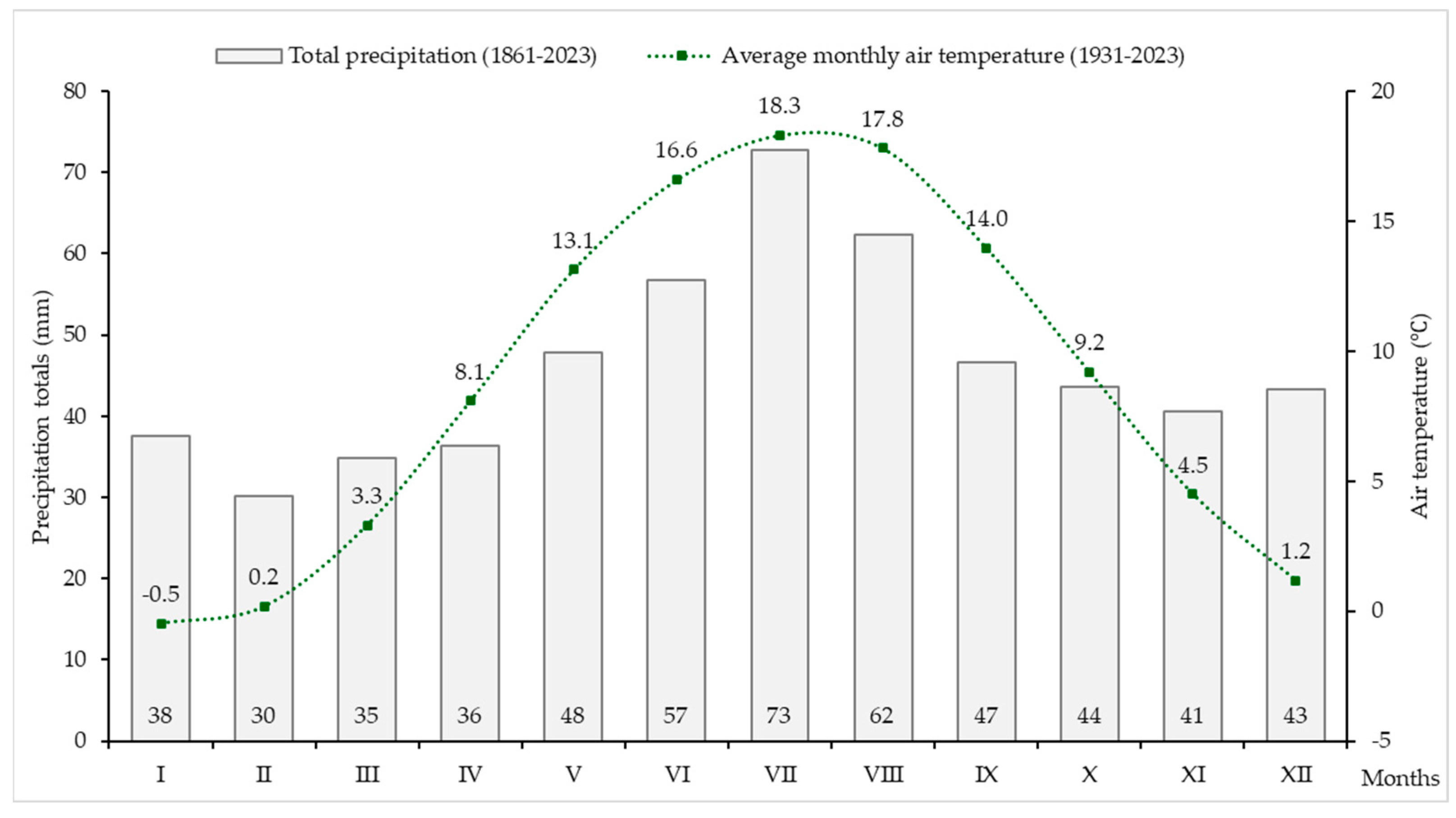
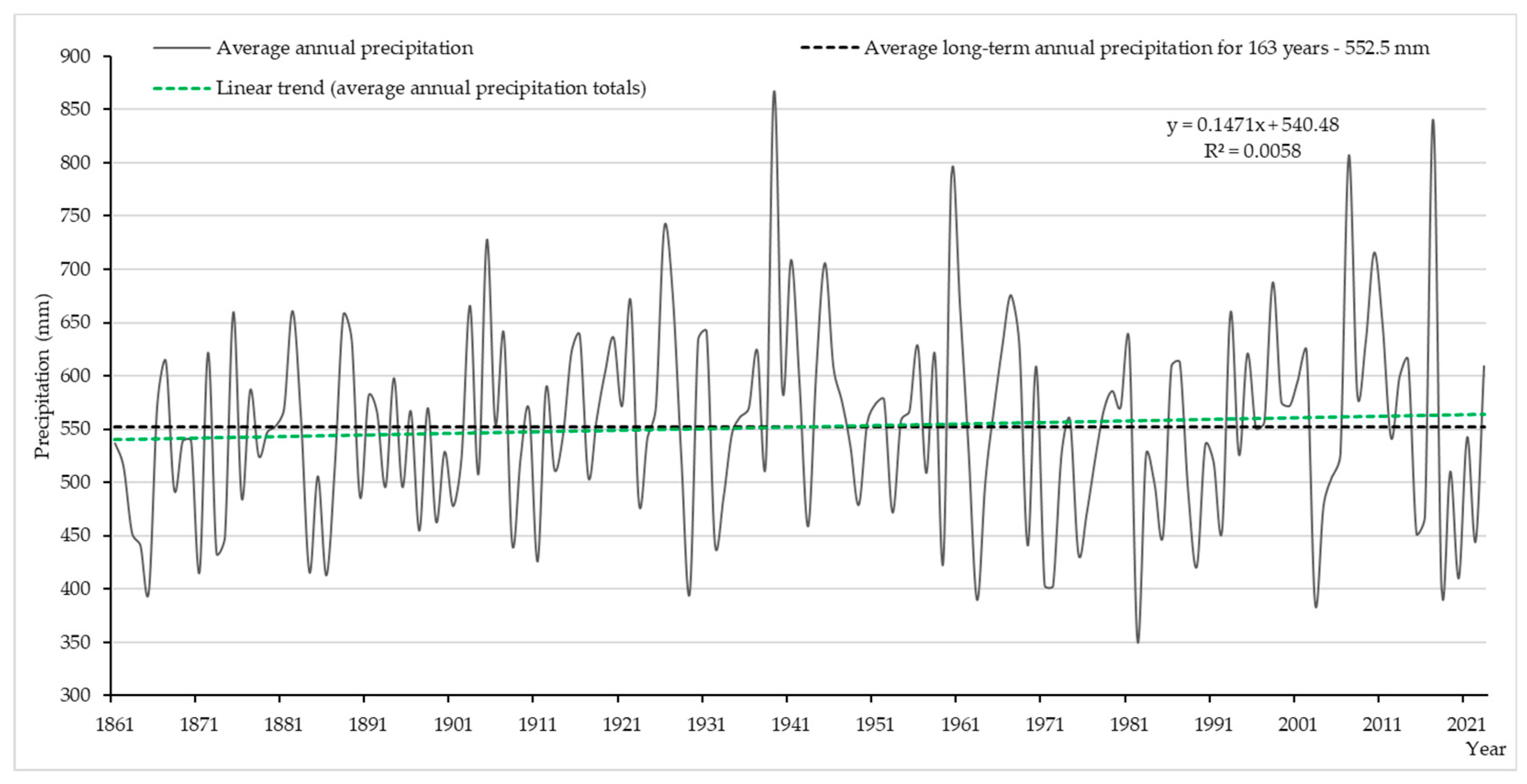
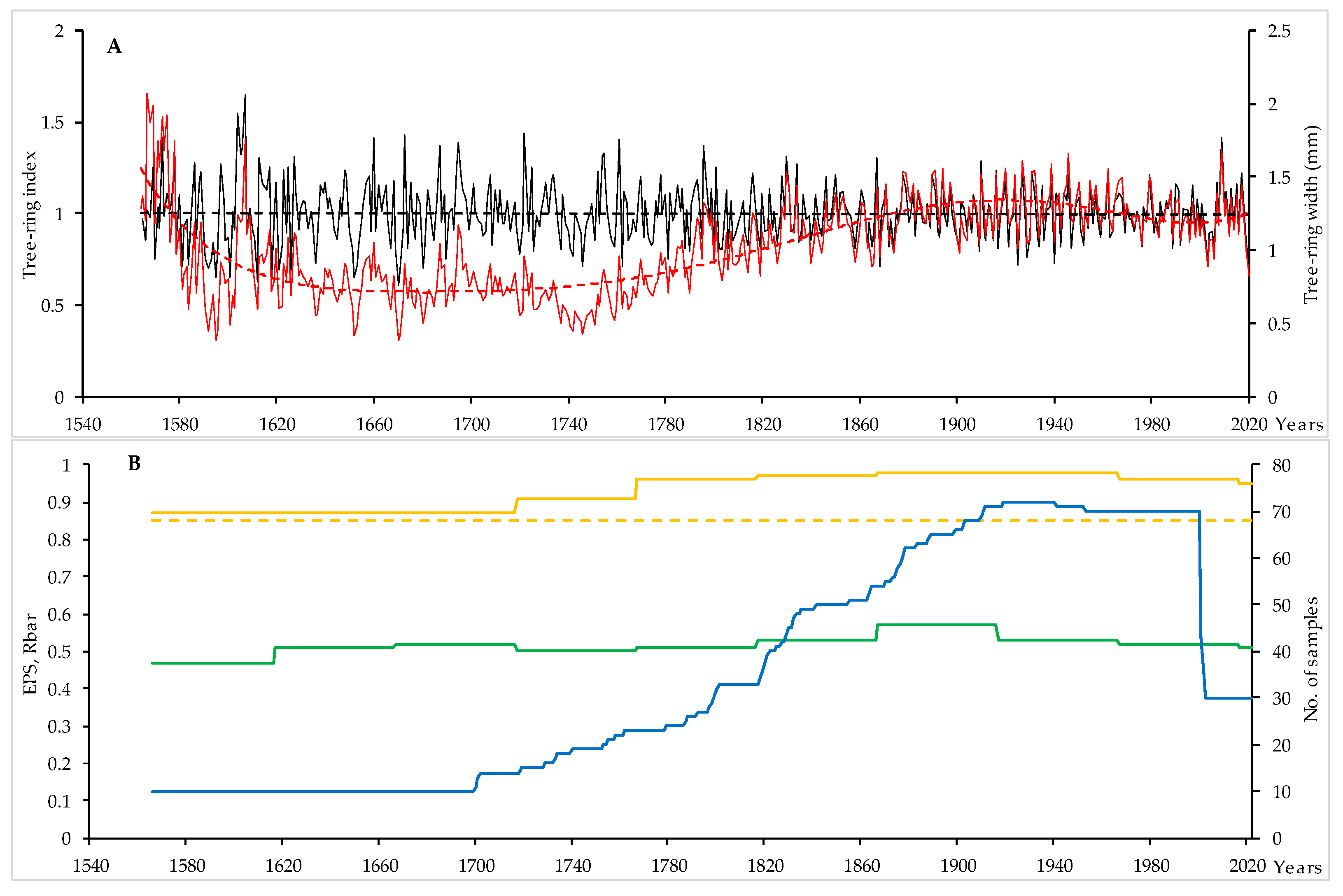
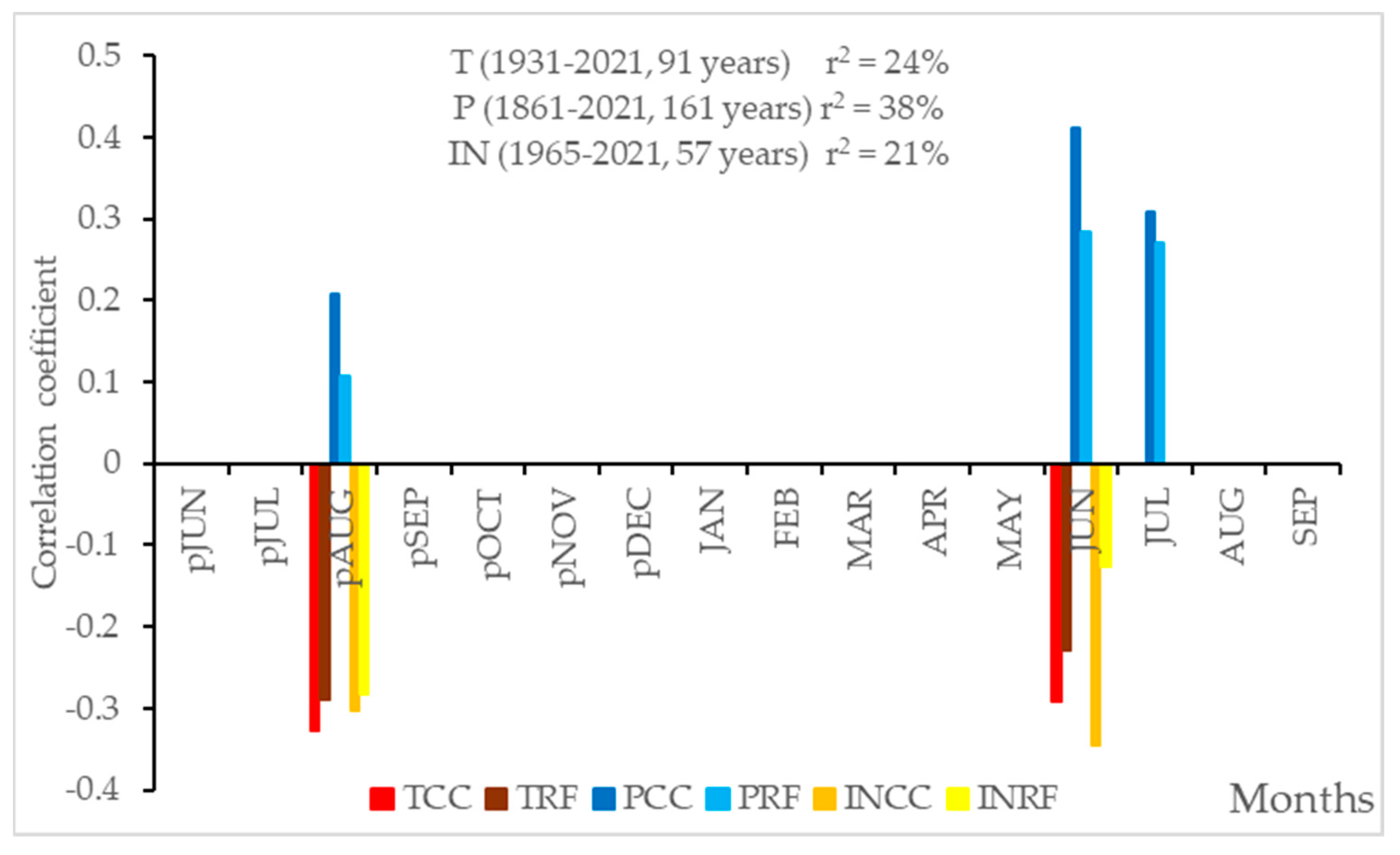


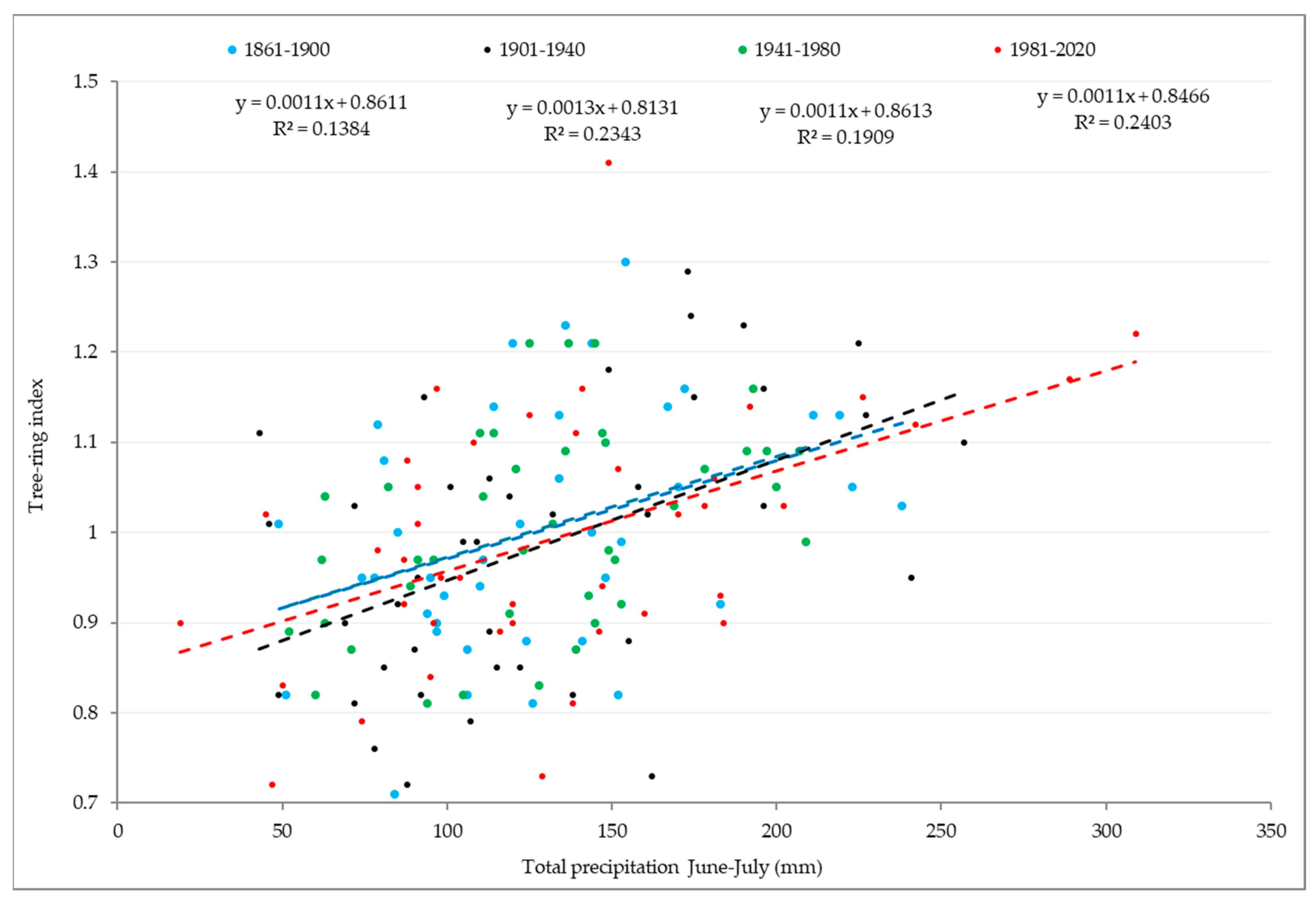
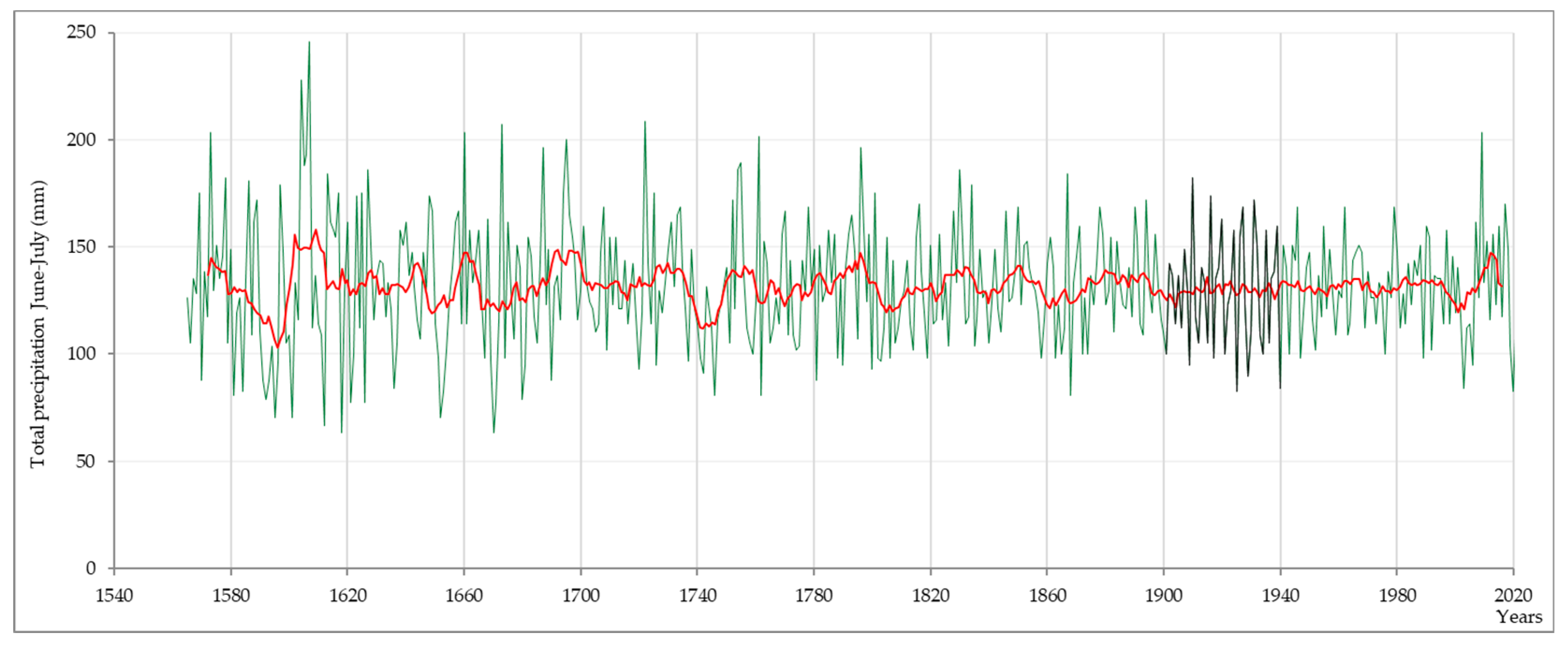
| Period (Years) | Estimate (mm) | Statistic | p | 95% CI |
|---|---|---|---|---|
| 1861–1900 | 3.69 | 0.55 | 0.588 | [−9.96, 17.34] |
| 1941–1980 | 3.68 | 0.60 | 0.555 | [−8.82, 16.19] |
| 1981–2020 | −2.65 | −0.30 | 0.763 | [−20.31, 15.00] |
| June–July Precipitation Sum (Z-Score) | Year | Description of the Phenomena | Additional Background Information | Source |
|---|---|---|---|---|
| 138.6 (+0.2) | 1571 | Cold, rainy spring, cold, rainy summer. | Eine Sammlung unterschiedlicher die Historie der Stadt Cöslin betreffende Sachen, Johan David Wendland, Koszalin 2006. | |
| 117.6 (−0.5) | 1572 | Dry, sunny summer. | Eine Sammlung unterschiedlicher die Historie der Stadt Cöslin betreffende Sachen, Johann David Wendland, Koszalin 2006. | |
| 180.7 (+1.7) | 1586 | Long, harsh winter with abundant snow. The Odra River froze overnight. Cold, rainy spring, cool, rainy summer. | Severe grain crop failure. Very high prices and hunger in Pomerania, severe grain shortages. | Gustav Henric Schwallenber, Historia Pomeraniae Pragmatica, no date (early 18th century) in: APS, RiS, 451, Geschichte von Belgard, 1938 in: APS, RiS, 1236, Historische Beschreibung der Stadt Alten Stettin in Pommern, durch Paulum Friedeborn, Altes Stettin 1613. |
| 108.8 (−0.8) | 1587 | Long, harsh and snowy winter. Cold, rainy spring, cool, rainy summer. | Severe grain crop failure. Very high prices and hunger in Pomerania, severe grain shortages. | Gustav Henric Schwallenber, Historia Pomeraniae Pragmatica, no date (early 18th century) in: APS, RiS, 451, Geschichte von Belgard 1938 in: APS, RiS, 1236, Historische Beschreibung der Stadt Alten Stettin in Pommern, durch Paulum Friedeborn, Altes Stettin 1613. |
| 171.9 (+1.4) | 1589 | Very dry and hot summer. | There are no previous data from 1588. In 1589, the heat made breathing difficult. Forests spontaneously ignited, rivers dried, mills stopped, and grain dried. | Historische Beschreibung der Stadt Alten Stettin in Pommern, durch Paulum Friedeborn, Altes Stettin 1613. |
| 228.1 (+3.4) | 1604 | Mild, rainy winter, warm, rainy spring, warm summer. | There are no previous data from 1603. In 1604, abundant grains. First favorable year after 1600. | Historische Beschreibung der Stadt Alten Stettin in Pommern, durch Paulum Friedeborn, Alten Stettin 1613. |
| 136.9 (+0.2) | 1609 | Long, harsh and snowy winter, rainy, cool spring. | There are no previous data from 1608. In 1609, grain crop failure. | Eine Sammlung unterschiedlicher die Historie der Stadt Cöslin betreffende Sachen, Johan David Wendland, Koszalin 2006. |
| 175.4 (+1.5) | 1617 | Cold, rainy winter, cool, rainy summer. | There are no previous data from 1616. In 1617, bread shortages, high food prices, scarce fruit crops. | Filipa Hainhofera dziennik podróży zawierający obrazki z Frankonii, Saksonii, Marchii Brandenburskiej i z Pomorza w 1617 roku, analysis by Krzysztof Gołda 2nd edition, edited by R. Skrycki, Szczecin 2020. |
| 150.9 (+0.7) | 1628 | Long, harsh winter, rainy, cold spring. | Grain crop failure. | LAG, Rep. 40, Handschriften, II/20 |
| 163.2 (+1.1) | 1668 | Mild, rainy winter, rainy, warm spring, good, mild summer. | Abundant grain crops, good crops also in Poland. | APS, Collection of Evangelical Parish Books from Pomerania and Neumark, 2. |
| 131.6 (0.0) | 1691 | Long, harsh winter, cold and rainy spring, cold and rainy summer. | In 1690, rainy spring and summer. In 1691, grain crop failure. | APS, AKS, I/5320, I/5321. |
| 136.9 (+0.2) | 1692 | Long, harsh winter, cold and rainy spring, cold summer. | Grain crop failure. Subjects complaining about bread shortages and great poverty. Reports of grain imports to Pomerania from other provinces of the Brandenburg state. | APS, AKS, I/5320, I/5321. |
| 168.4 (+1.3) | 1708 | Long, harsh and snowy winter, cold, rainy spring. | Grain crop failure. | Eine Sammlung unterschiedlicher die Historie der Stadt Cöslin betreffende Sachen, Johan David Wendland, Koszlin 2006. |
| 175.4 (+1.5) | 1725 | Cold, rainy spring and cool, rainy summer. | Severe grain crop failure. | Eine Sammlung unterschiedlicher die Historie der Stadt Cöslin betreffende Sachen, Johan David Wendland, Koszalin 2006. |
| 164.9 (+1.2) | 1733 | Long and harsh winter, cold, rainy spring, cold summer. | In 1732, a peculiar year, various diseases and plagues, mild winter, frost only in February, then a lot of rain. In 1733, severe grain crop failure. | APS, AKS, I/5556, Eine Sammlung unterschiedlicher die Historie der Stadt Cöslin betreffende Sachen, Johan David Wendland, Koszalin 2006. |
| 168.4 (+1.3) | 1734 | Long and harsh winter, cold, rainy spring, cold summer. | Severe rye crop failure. | APS, AKS, I/5556. |
| 140.4 (+0.3) | 1735 | Long and harsh winter, rainy, cold spring. | Grain crop failure, grain shortages in the market. | Eine Sammlung unterschiedlicher die Historie der Stadt Cöslin betreffende Sachen, Johan David Wendland, Koszalin 2006. |
| 149.1 (+0.6) | 1738 | Long, harsh winter, temperatures dropping to −32 degrees, cold, rainy spring. | In 1737, there was a huge shortage of food, people ate anything, hunger, rainy spring and summer. In 1738, severe grain crop failure, soaring prices. | Eine Sammlung unterschiedlicher die Historie der Stadt Cöslin betreffende Sachen, Johan David Wendland, Koszalin 2006. |
| 131.6 (0.0) | 1743 | Rainy, cold spring, rainy, cool summer. | There are no previous data from 1742. In 1743, severe grain crop failure, soaring prices. | Eine Sammlung unterschiedlicher die Historie der Stadt Cöslin betreffende Sachen, Johan David Wendland, Koszalin 2006. |
| 115.8 (−0.6) | 1747 | Rainy winter, cold, rainy spring, cool summer. | Severe grain crop failure, soaring prices. | Eine Sammlung unterschiedlicher die Historie der Stadt Cöslin betreffende Sachen, Johan David Wendland, Koszalin 2006. |
| 171.9 (+1.4) | 1752 | Long, harsh winter, cold, rainy spring, cold, rainy summer. | In 1751, severe frosts winter, cold wet spring. In 1752, heating was required as late as St. John’s Day. Strong frosts lasted until late March. Grain crop failure. | Eine Sammlung unterschiedlicher die Historie der Stadt Cöslin betreffende Sachen, Johan David Wendland, Koszalin 2006. |
| 186.0 (+1.9) | 1754 | Long, harsh winter, long, rainy and cold spring, cold summer. | In 1753, only mention of a harsh winter. In 1754, fields were covered by snow for a long time. Grain crop failure, soaring prices. | Eine Sammlung unterschiedlicher die Historie der Stadt Cöslin betreffende Sachen, Johan David Wendland, Koszalin 2006. |
| 189.5 (+2.0) | 1755 | Long winter with a lot of snow, blizzards, strong frosts, cold, rainy spring, cold, rainy summer. | Severe grain crop failure (especially rye) caused by very low temperatures and a durable snow cover. | APS, AKS, I/5557, Eine Sammlung unterschiedlicher die Historie der Stadt Cöslin betreffende Sachen, Johan David Wendland, Koszalin 2006. |
| 201.8 (+2.5) | 1761 | Short winter, rainy spring, warm summer. | Regular transports of grain to Szczecin from 28 January to 30 December 1761. Good conditions on waterways and roads. | Wochentlich—Stettinische Frag—und Anzeigungs—Nachrichten, 1761, No 1–52. |
| 156.1 (+0.9) | 1769 | Mild, warm winter, summer with good crops. | Ship traffic in the harbor from 11 January throughout the year until January 1770, uninterrupted grain transports to the city. | Wochentlich—Stettinische Frag—und Anzeigungs—Nachrichten, 1769, No 1–52. |
| 166.7 (+1.2) | 1770 | Mild, warm winter, warm summer with good crops. | Ship traffic in the harbor nearly throughout the year, except for a break from 3 January to 14 February, regular transports of grain to the city. | Wochentlich—Stettinische Frag—und Anzeigungs Nachrichten, 1770, No 1–52. |
| 168.4 (+1.3) | 1778 | Harsh, short winter, warm, rainy summer, warm autumn. | Ship traffic ceased from late December 1777 to early April 1778. Intense ship traffic and grain transport throughout the summer. Ship traffic ended in late December 1778. | Stettiner Intelligenz Zettel, 1778, No 1, 3, 5, 7, 9, 13, 15, 17, 19, 21, 23, 25, 27, 29, 53, 55. 57, 59, 61, 63, 65, 67, 69, 71, 89, 91, 93, 95, 97, 99, 101, 103. |
| 156.1 (+0.9) | 1792 | Short, relatively mild winter, warm, rainy spring, warm summer. | Ship traffic suspended from 21 December 1791 to 8 February 1792 and again from 22 February to 14 March 1792. Following that, both ship traffic and grain transports were regular. Due to positive temperatures, ship traffic in the harbor lasted until early January 1793. | Sttetiner Intelligenz Zettel, 1791, No 100, 102, 104, 1792, No 2, 4, 6, 8, 10, 12, 14, 18, 20, 22, 24, 54, 56, 58, 60, 62, 64, 66, 68, 70, 72, 88, 90, 92, 94, 96, 98, 100, 102, 104. |
| 164.9 (+1.2) | 1793 | Short, mild winter, warm, rainy summer, warm, rainy autumn. | Ship traffic ceased on 2 January 1793 and resumed after 27 February. Following that, ship traffic was regular and vast quantities of grain were delivered to the city. The harbor functioned throughout December 1793 until 8 January 1794. | Stettiner Intelligenz Zettel, 1793, No 1, 3, 5, 7, 9, 11, 13, 15, 17, No 19, 53, 55, 57, 59, 61, 63, 65, 67, 69, 71, 73, 91, 95, 97, 99, 101, 103, 1794, No 1, 3, 5. |
| 196.5 (+2.3) | 1796 | Mild, warm winter, mild, warm summer, abundant grain crops, warm autumn. | Ship traffic in the harbor continued throughout December 1795 and the winter months of 1796. In the summer months, the ship traffic in the harbor was intense, and large quantities of grain were delivered to the city. Ship traffic ceased on 7 December 1796. | Stettiner Intelligenz Zettel, 1795, No 95, 97, 99, 101, 103, 1796 No 3, 5, 7, 9, 11, 13, 15, 17, 19, 21, 53, 57, 59, 61, 63, 65, 67, 69, 71, 91, 93, 95, 97, 99, 101. |
| 175.4 (+1.5) | 1801 | Harsh, relatively short winter, warm summer, mild, long autumn. | Navigation season began in mid-March 1801. Intense ship traffic in the summer months. In summer, variable grain imports. In autumn, high grain imports. Ship traffic lasted until late December 1801. | Stettiner Intelligenz Zettel, 1800, No 101, 103, 1801, No 1, 3, 5, 7, 9, 11, 13, 15, 17, 19, 21, 23, 53, 55, 57, 59, 61, 63, 65, 67, 69, 71, 73, 91, 93, 95, 97, 99, 101, 103. |
Disclaimer/Publisher’s Note: The statements, opinions and data contained in all publications are solely those of the individual author(s) and contributor(s) and not of MDPI and/or the editor(s). MDPI and/or the editor(s) disclaim responsibility for any injury to people or property resulting from any ideas, methods, instructions or products referred to in the content. |
© 2024 by the authors. Licensee MDPI, Basel, Switzerland. This article is an open access article distributed under the terms and conditions of the Creative Commons Attribution (CC BY) license (https://creativecommons.org/licenses/by/4.0/).
Share and Cite
Cedro, A.; Wilczyński, S.; Wertz, B.; Gaziński, R.; Kirschenstein, M.; Sztajner, P.; Musielak, S. Reconstruction of Summer Rainfall over the Last Five Centuries Based on Oak Chronology (Western Pomerania, Poland). Atmosphere 2024, 15, 1047. https://doi.org/10.3390/atmos15091047
Cedro A, Wilczyński S, Wertz B, Gaziński R, Kirschenstein M, Sztajner P, Musielak S. Reconstruction of Summer Rainfall over the Last Five Centuries Based on Oak Chronology (Western Pomerania, Poland). Atmosphere. 2024; 15(9):1047. https://doi.org/10.3390/atmos15091047
Chicago/Turabian StyleCedro, Anna, Sławomir Wilczyński, Bogdan Wertz, Radosław Gaziński, Małgorzata Kirschenstein, Przemysław Sztajner, and Stanisław Musielak. 2024. "Reconstruction of Summer Rainfall over the Last Five Centuries Based on Oak Chronology (Western Pomerania, Poland)" Atmosphere 15, no. 9: 1047. https://doi.org/10.3390/atmos15091047
APA StyleCedro, A., Wilczyński, S., Wertz, B., Gaziński, R., Kirschenstein, M., Sztajner, P., & Musielak, S. (2024). Reconstruction of Summer Rainfall over the Last Five Centuries Based on Oak Chronology (Western Pomerania, Poland). Atmosphere, 15(9), 1047. https://doi.org/10.3390/atmos15091047








